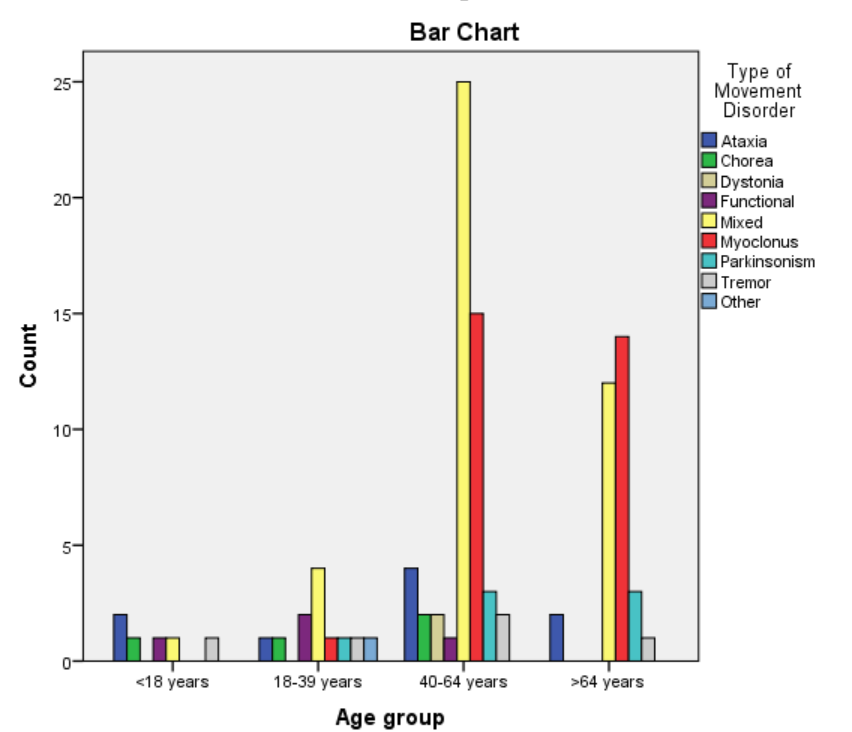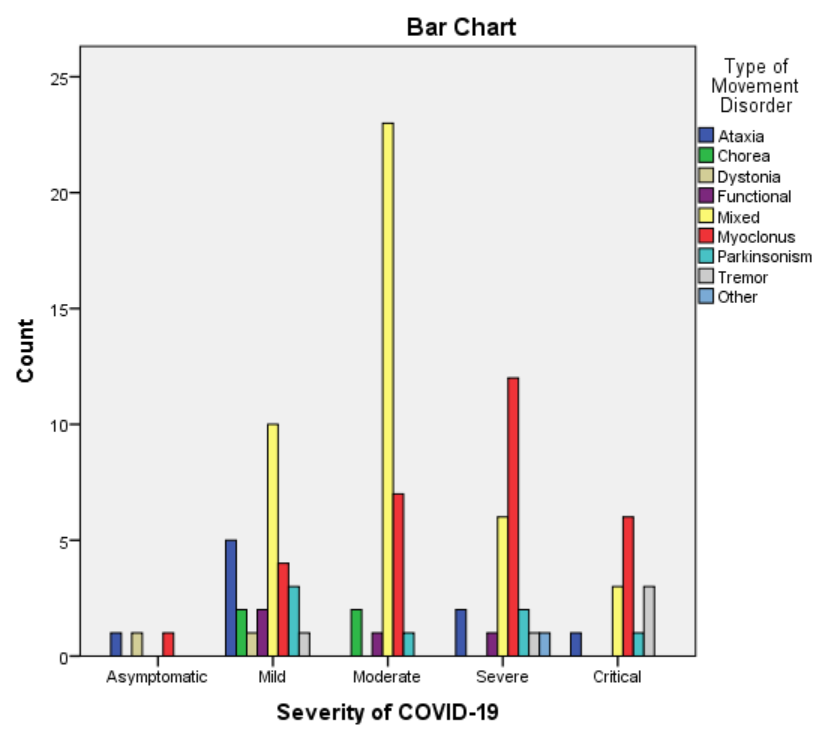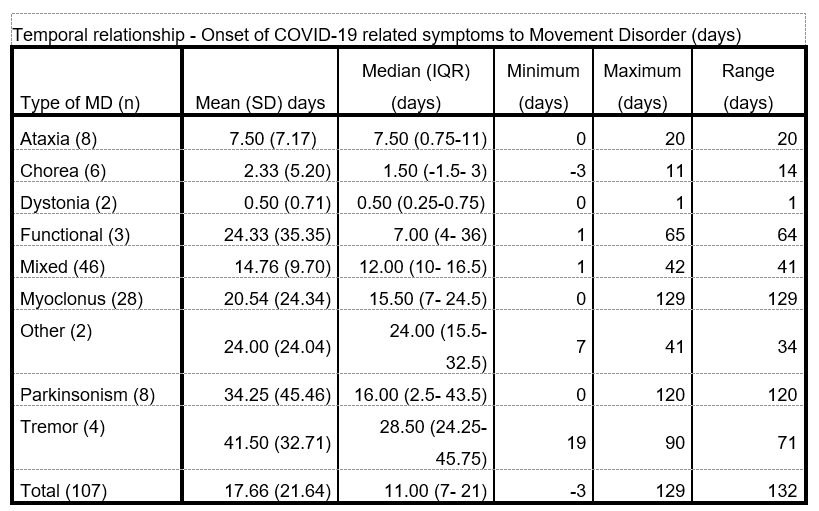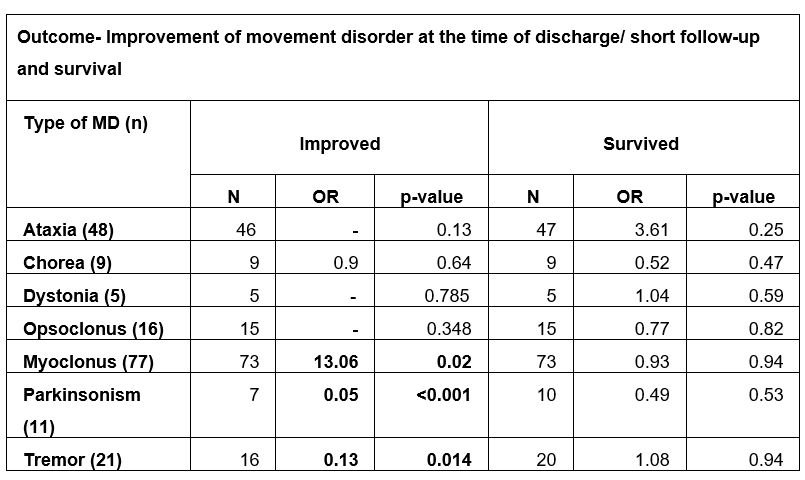Category: Other
Objective: We conducted a systematic review to describe the frequency, clinical profile and outcomes of patients with SARS-CoV-2 associated movement disorders.
Background: SARS-CoV-2 is associated with neurological manifestations, including various movement disorders (MD). SARS-CoV-2 induced MD can be a direct consequence of infection or can be immune-mediated.1 Despite a small proportion of patients developing MD, the frequency appears to be high in the neurology clinics, likely due to the high frequency of SARS-CoV-2 infection. A thorough review of individual patients with SARS-CoV-2 induced MD would help in better understanding the clinical profile and outcome of these patients and in prognostication.
Method: A systematic literature search of Pubmed, MEDLINE, EMBASE databases was conducted by two independent reviewers. Individual patient data from case reports and case series on SARS-CoV-2 associated MD, published between December 2019 and February 2022, were extracted and analysed.
Results: We analysed data of 118 patients with SARS-CoV-2 associated MD from 73 studies. Mean age was 55 ±18 years; 78% were males. The most frequent MD was a combination of myoclonus and ataxia (28.8%). Myoclonus significantly correlated with age (OR-1.04, p=0 0.03) and was most frequent in patients >40 years of age. Distribution of MD based on age and severity of SARS-CoV-2 are given in Figures [1] and [2], respectively. The latency to develop a MD after SARS-CoV-2 was highest for tremor (41.5±32.7days). The temporal relationship of onset of different MD with SARS-CoV-2 infection is summarised in Table [1]. Co-morbidities didn’t influence the type of MD. Myoclonus showed a significant correlation with improvement at the time of discharge (OR-13, p=0.02), whereas tremor and parkinsonism correlated negatively with improvement (OR-0.13, p=0.014 and OR-0.05, p=<0.001, respectively). No correlation was seen between the type of movement disorder and survival (Table [2]).
Conclusion: Myoclonus-ataxia syndrome was the most frequent SARS-CoV-2 associated MD reported in the literature and its presence should prompt testing for SARS-CoV-2 infection in an appropriate clinical setting.2,3 Myoclonus was more frequent in patients aged >40 years. Chorea, dystonia and ataxia develop within a shorter latency period, whereas tremor, myoclonus and parkinsonism can develop weeks after infection. The type of movement disorder doesn’t influence the survival outcome.
References: 1. Ghosh R, Biswas U, Roy D, et al. De Novo Movement Disorders and COVID-19: Exploring the Interface. Mov Disord Clin Pract. 2021;8(5):669-680. doi:10.1002/mdc3.13224
2. Hirschfeld AS. Autoimmune mediated hyperkinetic movement disorders in SARS-CoV-2 infection – a systematic review. Neurol Neurochir Pol. Published online October 12,
2021. doi:10.5603/PJNNS.a2021.0069
3. Rosca EC, Vastag Z, Phokaewvarangkul O, Sringean J. Movement Disorders Induced by SARS-CoV-2 Infection: Protocol for a Scoping Review. J Clin Med. 2022;11(4):923.
doi:10.3390/jcm11040923
To cite this abstract in AMA style:
K. Pillai, S. Mishra, G. Siripurapu, A. Aliyar, R. Rajan, A. Srivastava, D. Radhakrishnan. A systematic review of Movement Disorders in COVID-19 [abstract]. Mov Disord. 2022; 37 (suppl 2). https://www.mdsabstracts.org/abstract/a-systematic-review-of-movement-disorders-in-covid-19/. Accessed December 24, 2025.« Back to 2022 International Congress
MDS Abstracts - https://www.mdsabstracts.org/abstract/a-systematic-review-of-movement-disorders-in-covid-19/




